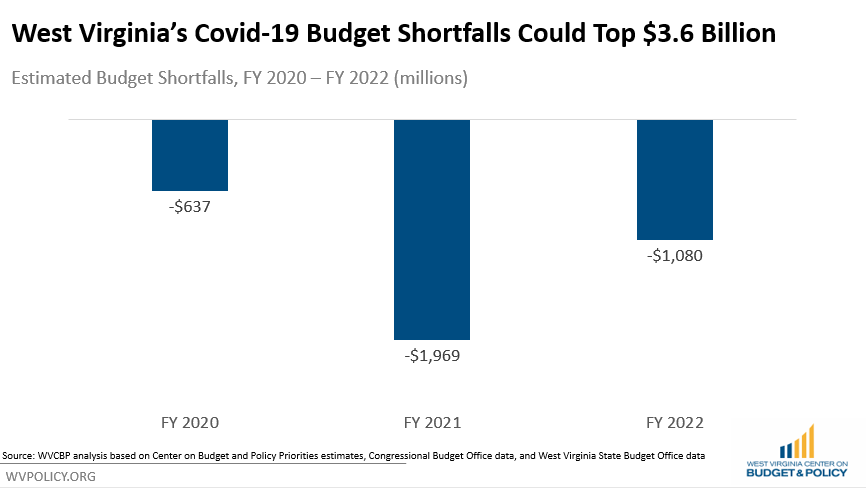The pressure on the state budget from the COVID-19 pandemic and resulting economic fallout continues to mount. In April, state revenue collections were $192 million below estimates, setting the stage for what could be a total $500 million shortfall by the end of the fiscal year.
Moreover, recent economic projections from the Congressional Budget Office (CBO) suggest that West Virginia’s, as well as states across the country, budget problems are only going to get worse.
The CBO projects that unemployment will average 15 percent for the next six months and then fall only slowly. It will still be 9.5 percent — just short of its 10 percent peak in the Great Recession — at the end of 2021. These CBO estimates take into account the federal aid already enacted for businesses, individuals, and state and local governments. West Virginia’s unemployment rate in March 2020 was 6.1 percent, however, with 120,000 continued unemployment claims in the last week April, the state’s unemployment rate is currently likely closer to 19 percent.
Historically, a 1 percentage point increase in the unemployment rate translates into roughly a $45 billion decrease in state budgets. According to the Center on Budget and Policy Priorities, the latest CBO projections mean that states could face budget shortfalls totaling $650 billion over the next three years, including $110 billion for FY 2020, $350 billion for FY 2021, and $190 billion for FY 2022.
According to the latest state budget information from the National Association of State Budget Officers, state general budgets totaled $892 billion in FY 2020. That means the estimated budget shortfalls are equivalent to an average 12% shortfall in FY 2020, a 39% shortfall in FY 2021, and a 21% shortfall for FY 2022.
So how does that measure up for West Virginia? West Virginia’s FY 2020 base budget totaled $5.17 billion in FY 2020, and was projected to total $5.02 billion in FY 2021 and $5.07 billion in FY 2022.
Assuming that the estimated fiscal impact of increased unemployment is right at the national average, the CBO projections suggest that West Virginia will face a $637 million shortfall for FY 2020 (slightly higher than the $500 million currently being projected), a $1.97 billion shortfall in FY 2021, and a $1.08 billion shortfall in FY 2022, for a total shortfall of $3.69 billion through FY 2022.

The estimates from the Center on Budget and Policy Priorities and these estimated for West Virginia are in line with other estimates of the fiscal impact. The Upjohn Institute estimates that state and local governments will face a shortfall of $959 billion through the end of FY 2021, and Moody’s Analytics projects that West Virginia could see a $1.3 to $1.8 billion shortfall through FY 2021. It should be noted that the Moody’s estimate was before the latest CBO projections on unemployment were made.
West Virginia has recieved $1.25 billion in federal aid to deal with the coronavirus outbreak, but currently is not able to use that funding to replace lost revenue, and as these estimates show, that funding would not be nearly enough. Even if West Virginia were to use the entire $1.25 billion to close budget shortfalls, as well as using all $815 million the state’s Rainy Day Fund, the state would still be facing a fiscal hole of $1.6 billion.
In addition, these estimates do not include any local government shortfalls, nor any impact on the state road fund or special revenue accounts. The $1.25 billion that West Virginia has received was meant to cover both state and local government relief, so the fiscal need is even larger.
Like all states, West Virginia must balance its budget every year, even in a recession. Without substantial federal help, West Virginia will very likely be forced to make deep cuts to areas such as education and health care, lay off teachers and other workers, and cancel contracts with businesses. That would worsen the recession, delay recovery, and hurt families and communities.
This is why it’s vitally important that the next federal relief package should include a large new round of fiscal aid for state and local governments and that the aid continues as long as economic conditions remain depressed.